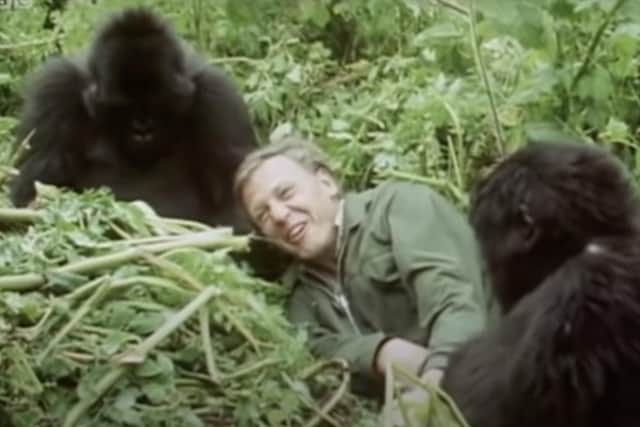How David Attenborough's encounter with wild mountain gorillas had a happy ending – Philip Lymbery
Deep among forest-clad slopes of Rwanda’s Virunga mountains, a young David Attenborough was creating one of the most iconic moments in wildlife history. He was meeting a family of endangered mountain gorillas. Looking a tad overdressed, he lay among several powerful apes, his sense of joy palpable. Despite being the consummate professional, his composure melted away as Poppy, a mischievous young gorilla, started removing his shoes.
“There is more meaning and mutual understanding in exchanging a glance with a gorilla than any other animal I know,” Attenborough said quietly to the camera. It was a bitter-sweet moment. As the two fellow creatures, man and gorilla, made a playful connection, Attenborough recognised he might be seeing some of the last of their kind.
Advertisement
Hide AdAdvertisement
Hide AdLike so many of us, Attenborough’s adventures have affected me deeply since I was a boy. Perhaps the world’s most celebrated naturalist, he’s been a constant source of inspiration ever since. Early March is marked by World Wildlife Day, an opportunity to celebrate the many beautiful and varied forms of wild fauna and flora and the benefits that their conservation provides to people.


Because the bottom line is that we’re all in this together; people and nature, we’re part of the same rich ecosystem that provides the air we breathe, the water we drink, the food we eat. How many times have I seen a picture of those master pollinators, the bees, alongside the phrase, “When we go, we’re taking you all with us!” Well, the same could be said for so many species.
In my lifetime, much of what was once wild has become domestic. Half the fertile land on the planet is now farmed, with humans and the animals we rear for food accounting by mass for 96 per cent of all mammals on Earth. Everything else, from elephants and wild bison to badgers and mice make up just 4 per cent. In the avian world, domestic poultry account for 70 per cent of birds by mass.
As David Attenborough writes in A Life on Our Planet, “this is now our planet, run by humankind for humankind. There is little left for the rest of the living world”. Things are now out of balance, and something needs to be done about it. Which is why I celebrate everyday those pioneers bringing back the wild and the wonderful. Those restoring once-extinct species like beavers; rewilding magnificent areas like the Carpathian mountains in Romania, Patagonia National Park in Chile, or Scotland’s Caledonian Forest; renaturing farmlands through regenerative farming practices. In this way, we can bring back nature, creating a sustainable future.
Way back on that Rwandan hillside, Poppy and her fellow gorillas faced a bleak future. When Attenborough arrived, they were on the brink of extinction. Their forest home was being rapidly converted for agriculture. Yet things ended well. The Rwandan government, conservationists and local communities worked together to preserve the gorillas’ habitat and Poppy grew up to have many offspring. “It just shows what we can achieve when we put our minds to it,” Attenborough has said. I couldn’t agree more.
Philip Lymbery is chief executive of Compassion in World Farming and a former United Nations Food Systems Champion. His latest book is Sixty Harvests Left: How to Reach a Nature-Friendly Future. Philip is on Twitter/X @philip_ciwf
Comments
Want to join the conversation? Please or to comment on this article.
